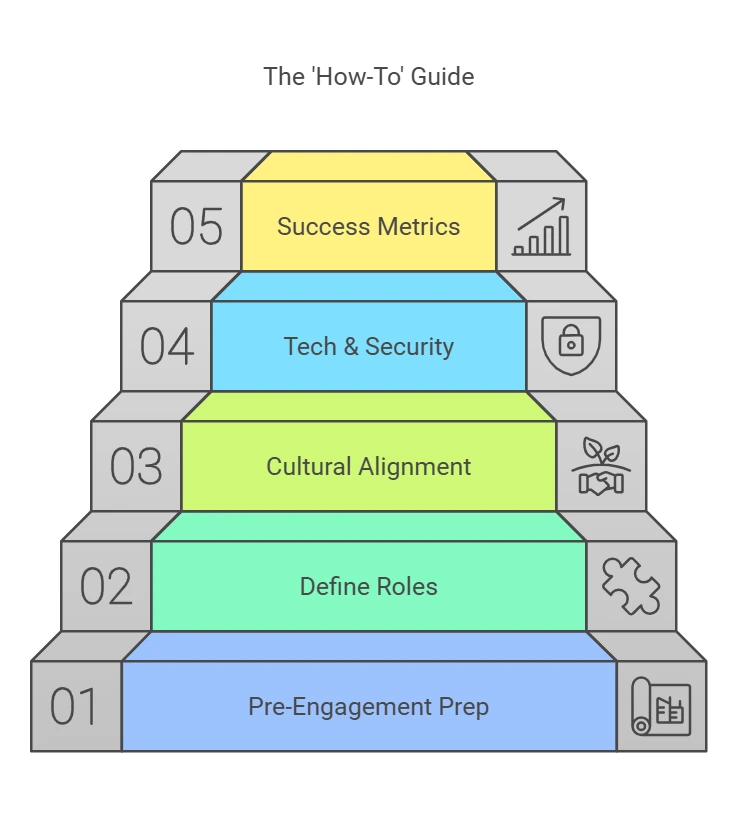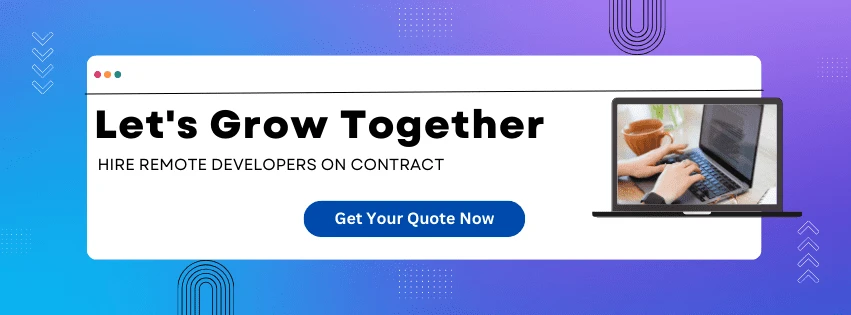Globalization has made everyone very well connected, which has further created space and a broad scope for offshore development in 2025. This particular method of hiring has many advantages, including access to global talent, cost savings, and faster project turnarounds. However, these benefits are possible only after the team practices a smooth, seamless, and efficient onboarding process. Between the contract getting signed and the day your offshore developers start working on your projects, many steps need to be fulfilled. By streamlining the onboarding journey, you are setting the stage for productive relationships, reduced misunderstandings, and accelerated timelines
In this ‘how-to’ guide, we will break down the key considerations and strategies that can lead to efficient onboarding of offshore developers. From the documents needed in your initial conversation to your final contract, we will help you understand the process which if followed, will guarantee you success in 2025.
1. Laying the Foundation: Pre-Engagement Preparation
The groundwork you lay before the contract is signed with your offshore development company will determine the quality of the onboarding process and your relationship in the future. Preparation ensures that once the ink is dry on those papers, your new developers can hit the ground running.
-
Conduct Thorough Vendor and Talent Assessments:
Start your journey with a deep breath and a thorough assessment of potential offshore partners. In the initial stages, ditch the worry of costs and check their track record, technical capabilities, communication style, and cultural alignment. Checking their experience compatibility with your project is very necessary. Are they familiar with the technologies you want to integrate? Ponder over these aspects before moving further.
-
Identify Your Project Scope and Roadmap:
Before conversing with the offshore developers, make sure that you have laid down a project-scope, along with the deliverables, timelines, and expected outcomes. If you communicate your needs properly, your offshore provider will be able to deliver in the manner you want. Vague explanations will only lead to gaps in the project.
-
Set Clear Objectives and KPIs:
Clarity is paramount. Explain the objective behind hiring offshore developers- whether it is for accelerating product development, exploring new technologies, or reducing overall costs. Establish relevant KPIs that will measure the success. By having quantifiable goals, you create a shared understanding of what the partnership aims to achieve, guiding the entire onboarding experience.
-
Document Best Practices and Standards:
Before your project begins, prepare the necessary documents that will specify your internal coding standards, development technologies, preferred tools, brand references, etc. Providing a rough handbook will set the standard and guidelines. This way, your offshore developer can have a baseline from day one.
Learn More: How outsourcing can help streamline your IT department in 2025
2. Documenting and Defining Roles, Responsibilities, and Expectations
Once the contract is finalized, the next phase is integrating your offshore developers into a customized workflow. The key to a seamless transition is ensuring that everyone understands their role, responsibilities, and expectations.
-
Create Detailed Role Descriptions:
Developer onboarding is simplified when all the team members know their particular tasks. Assign clear job descriptions, emphasising on their primary tasks, the technologies they’ll use, and the metrics they’ll be evaluated against. Clarity in roles reduces guesswork and empowers the new developers to start contributing meaningfully.
-
Outline Reporting Structures and Communication Protocols:
The reporting structure of the parent company should be explained in detail to the offshore developers, so that their is no lapse in communication. Specify your communication tools. By establishing these workflows you are preventing confusion and fostering accountability.
-
Set Performance Expectations and Deadlines:
Provide realistic timelines and clarify what “on-time” delivery means. Offer benchmarks for code quality, feature completion, and testing coverage. When everyone understands the performance bar they’re aiming for, it’s easier to maintain consistency and meet project milestones without surprises.
-
Formalize Onboarding Checklists and Training Sessions:
Consider developing an organized onboarding checklist to walk your new developers through key activities including setting up their work environment, accessing the repository, examining the codebase, and attending obligatory training sessions. Formalizing this approach guarantees that no important stages are overlooked and that new team members become productive as quickly as possible.
3. Ensuring Cultural and Communication Alignment
Successful offshore developer onboarding requires effective communication and proper cultural alignment. There are many factors that can create friction, like time zone differences, language nuances, and different working styles.
-
Foster a Culture of Inclusion and Respect:
Since your offshore teams hail from a part of the world different from yours, make sure to recognize their cultural backgrounds. Embrace an environment where everyone respects different communication styles, holidays, and traditions. This inclusivity builds trust and loyalty, making your team more cohesive over the long run.
-
Leverage Communication Tools and Techniques:
With a global team, asynchronous communication often becomes the norm. Ensure you have the right tools in place—chat platforms, project management systems, and file-sharing solutions. Consider recording important meetings and sharing summaries for those who can’t attend live due to time zone differences. Implementing standard communication practices, such as using clear subject lines in emails or having structured daily stand-ups, keeps everyone aligned.
-
Regular Check-ins and Feedback Loops:
Instill a habit of regular check-ins- both one-on-one and with the whole team. These discussions are an opportunity for offshore developers to raise issues, seek clarifications, and offer feedback, which can help the parent company grow. This helps solve major obstacles before they arise.
4. Technology, Tools, and Security Considerations
Providing offshore developers with the right technological environment and securing your intellectual property (IP) is critical. The smoother the technical integration, the faster your new team members can start contributing effectively.
-
Streamline Access Management:
Before the work begins, ensure that the developers have the correct permissions and credentials. Set up single sign-on solutions, create separate development and production environments, and document how to acess repositories, databases, and code review tools. By handling these technical steps upfront, you remove potential bottlenecks that could delay productivity.
-
Introduce the Tooling Ecosystem Early:
Prepare and share a list of the tools and technologies that your team use- IDEs, testing frameworks, continuous integration (CI) systems, and issue trackers. Provide a step-by-step guide or recorded demos to help the new developers get familiar with the development environment quickly. The faster they adapt, the better they can deliver.
-
Prioritize Security Measures:
Onboarding of these developers isnt just about getting people up to speed; its also about ensuring that your sensitive information remains protected. Emphasize security best practices, including the use of VPNs, encryption protocols, and secure coding guidelines. Outline data protection policies, role-based access controls, and intellectual property arrangements in a straightforward manner.
-
Backup and Disaster Recovery Planning:
Ensure your offshore developers know the protocols for backing up code, reporting security incidents, and handling downtime. Having a disaster recovery plan and making sure your offshore team understands it will go a long way toward preventing disruptions and instilling confidence in your organization’s preparedness
5. Setting Success Metrics and Continuous Improvement
Onboarding is not a one-time event. It is a dynamic process that can and should be improved over time. By establishing clear success indicators and continuously assessing your strategy, you can guarantee that your offshore developer onboarding process is efficient and successful.
-
Define Measurable Success Indicators:
Success measuring indicators can differ from company to company, and it is important to specify and track your metrics diligently. Keeping an eye on KPIs like “time to productivity” or “error rates in initial code commits” helps you understand whether your onboarding is effective.
-
Gather Feedback from Multiple Sources:
Don’t rely solely on top-down evaluation. Seek feedback from the offshore developers themselves- after all, they are the ones experiencing the process of onboarding firsthand. Ask the existing team members how well new arrivals are blending. Soliciting these perspectives helps you identify blind spots and areas that need refinement.
-
Promote upskilling
Regularly promote the upskilling of your employees, may that be the developers or the regular employees. As upper management, the staff working under you depends on your leadership and guidance, combined with the experience that you bring to the table. Suggest courses or books that they can read, which will help build their knowledge.

Bringing It All Together: A Streamlined Offshore Developer Onboarding in Action
Let us explore a hypothetical circumstance. Your tech company in the United States just inked a deal with an Indian offshore development partner. Before the ink dried, your internal team created a clear project strategy, coding standards, and realistic performance objectives. With the contract in hand, you swiftly start defining the responsibilities of the offshore developers, establishing communication protocols, and supplying them with documentation on your toolsets and frameworks.
Your onboarding checklist walked them through creating the development environment, accessing the code repository, and reading previous project sprints and release notes. Regular check-ins helped identify cultural differences, such as holiday calendars and preferred communication patterns, which you swiftly handled. With strong security standards and access restrictions in place, your offshore staff felt confident that they were entering a well-organized and safe environment.
As the weeks passed, you tracked key performance indicators (KPIs) such as “time to first code commit” and “first successfully delivered feature.” Periodic feedback sessions indicated that, while the documentation was adequate, giving a taped introduction to your CI process would have been beneficial. You implemented that change right away, optimizing the process for future hiring.
Conclusion
Effective offshore developer onboarding may be the difference between a successful, long-term engagement and one plagued by delays and misunderstandings. You provide the groundwork for success by thoroughly planning, clarifying responsibilities, aligning cultures, utilizing the correct tools, guaranteeing security, and continually refining procedures based on feedback.
When done correctly, productivity increases, code quality remains high, and projects run smoothly from beginning to end. This technique not only saves time and costs, but also makes global talent feel valued and integrated. Finally, “offshore developer onboarding” is more than just a buzzword; it is a strategic advantage in today’s globalized, technology-driven economy.
The hypothetical Indian offshore partner we mentioned above? That could be us! At GraffersID, we offer a pool of talented developers to choose from, all trained and skilled in various tech stacks, with the safety tag of them being in-house. You do not need to worry about training, cultural integration, or the various other aspects. Contact us today to learn more about our services. Lets Grow Together!





